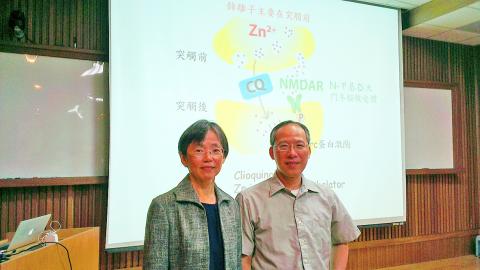An Academia Sinica study linking low zinc concentrations often detected in autistic people to genetic defects in two proteins suggests that autism-like behavior could be greatly ameliorated by boosting the transmission of zinc to the brain with the help of an antibiotic.
Academia Sinica research fellow and project leader Hsueh Yi-ping (薛一蘋) said her team obtained the results after performing an experiment on mice, which she said are sociable animals and therefore perfect test subjects.
Scientists compared the interactions of test mice by placing the subjects in a box, mice that had been unchanged, mice with their Tbr1 and Shank2 proteins “knocked off” and another “stranger” mouse.

Photo: Tang Chia-ling, Taipei Times
They found that unchanged mice engaged in high-level interaction with the “stranger” mouse, while mice with Tbr1 and Shank2 deficiencies interacted very little.
Hsueh’s team had previously determined that Tbr1 is a contributing factor of autism, while a team led by South Korean scientist and project coleader Eunjoon Kim discovered that Shank2 is also implicated in the condition.
Both deficiencies hamper the transmission of zinc ions to the NMDAR (N-methyl-D-aspartate) receptor, impairing function.
About 30 percent of children with autism suffer from zinc deficiency.
The researchers used clioquinol, an antibiotic used to increase zinc absorption, on the mice displaying autistic behavior and found that they began behaving in a way almost identical to that of the unchanged mice as both the level of activity and interaction with the “stranger” mouse increased, Hsueh said.
Clioquinol helps to move zinc from a presynaptic terminal to postsynaptic sites in the brain, where it undergoes a chain of chemical reactions before being picked up by the NMDAR receptor. The research teams concluded that the improvements displayed by the autistic mice were achieved with the presence of zinc.
Hsueh said that previous projects had determined that autism is linked to zinc deficiency, but the research undertaken by Academia Sinica and the South Korean researchers is the first to provide a scientific explanation for the phenomenon by establishing that the social inhibitions caused by autism can be changed by revitalizing the NMDAR receptor.
Hsueh said the results from the experiment conducted on mice can be extrapolated to humans, with a higher than 90 percent relevance between the two species.
She said that as clioquinol is a prescription drug permitted in Taiwan, her team hopes psychiatrists will prescribe the drug to suitable patients.
Citing US research, she said that autism is becoming more prevalent, with the chance of children developing the condition rising from one in every 88 children to one in every 68.
The scientific community believes that there are at least 900 genes in humans that could lead to autism, and that it is likely that the therapy can be used to target other genetic defects to improve autistic conditions, she said.
Hsueh recommends that people with autism who are diagnosed with zinc deficiency caused by the underexpression of the NMDAR receptor to increase their zinc intake by eating food high in zinc, such as oysters. She added that meat, which is rich in protein, helps boost zinc absorption.

ANOTHER EMERGES: The CWA yesterday said this year’s fourth storm of the typhoon season had formed in the South China Sea, but was not expected to affect Taiwan Tropical Storm Gaemi has intensified slightly as it heads toward Taiwan, where it is expected to affect the country in the coming days, the Central Weather Administration (CWA) said yesterday. As of 8am yesterday, the 120km-radius storm was 800km southeast of Oluanpi (鵝鑾鼻), Taiwan’s southernmost tip, moving at 9kph northwest, the agency said. A sea warning for Gaemi could be issued tonight at the earliest, it said, adding that the storm is projected to be closest to Taiwan on Wednesday or Thursday. Gaemi’s potential effect on Taiwan remains unclear, as that would depend on its direction, radius and intensity, forecasters said. Former Weather Forecast

As COVID-19 cases in Japan have been increasing for 10 consecutive weeks, people should get vaccinated before visiting the nation, the Centers for Disease Control (CDC) said. The centers reported 773 hospitalizations and 124 deaths related to COVID-19 in Taiwan last week. CDC Epidemic Intelligence Center Director Guo Hung-wei (郭宏偉) on Tuesday said the number of weekly COVID-19 cases reported in Japan has been increasing since mid-May and surpassed 55,000 cases from July 8 to July 14. The average number of COVID-19 patients at Japan’s healthcare facilities that week was also 1.39 times that of the week before and KP.3 is the dominant

The Chinese Communist Party’s (CCP) working group for Taiwan-related policies is likely to be upgraded to a committee-level body, a report commissioned by the Mainland Affairs Council (MAC) said. As Chinese President Xi Jinping (習近平) is increasingly likely to upgrade the CCP’s Central Leading Group for Taiwan Affairs, Taiwanese authorities should prepare by researching Xi and the CCP, the report said. At the third plenary session of the 20th Central Committee of the CCP, which ended on Thursday last week, the party set a target of 2029 for the completion of some tasks, meaning that Xi is likely preparing to

US-CHINA TRADE DISPUTE: Despite Beijing’s offer of preferential treatment, the lure of China has dimmed as Taiwanese and international investors move out Japan and the US have become the favored destinations for Taiwanese graduates as China’s attraction has waned over the years, the Ministry of Labor said. According to the ministry’s latest income and employment advisory published this month, 3,215 Taiwanese university graduates from the class of 2020 went to Japan, surpassing for the first time the 2,881 graduates who went to China. A total of 2,300 graduates from the class of 2021 went to the US, compared with the 2,262 who went to China, the document showed. The trend continued for the class of 2023, of whom 1,460 went to Japan, 1,334 went to